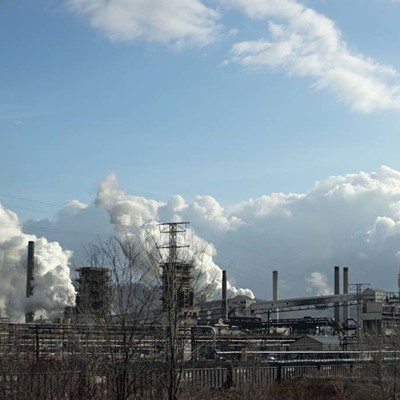Rural Sublette County, Wyo., is home to about 9,000 people, fewer than two per square mile. But as recently as three months ago, the smog in Sublette was worse than in Los Angeles on its worst day last year. One day in March, the ozone level was 124 parts per billion, or some 66 percent above what the U.S. Environmental Protection Agency considers healthy. According to the Associated Press, residents complained of shortness of breath, bloody noses and watery eyes. A day-care center canceled outdoor recess.
The bad air was caused by Wyoming's natural-gas industry. Between 2000 and 2008, the volume of gas produced in the county doubled, and the pristine air turned brown. In 2009, the state's Department of Environmental Quality concluded that of the principal pollutants serving as precursors to ozone (basically, smog), 94 percent of the volatile organic compounds and 60 percent of the nitrogen oxide emanated from gas operations.
Fort Worth, Texas, has 700,000 people; it also has more than 10,000 gas wells, including some in heavily developed areas. Fort Worth has smog, too, and a 2009 study out of Southern Methodist University concluded that gas and oil production contributed as much to smog formation as did all the metro area's cars and trucks combined.
Pennsylvania is experiencing its own natural-gas gold rush. Since early 2008, about 2,500 Marcellus Shale wells have been drilled, many in Southwestern Pennsylvania. And while critics have focused on drilling's impact on waterways, there is also "the potential for significant adverse health effects" from air pollution, says Bernard Goldstein, a public-health scholar at the University of Pittsburgh, among other observers.
Air pollution can come from wells themselves, but most seems to waft from adjacent processing and distribution facilities -- things like condensate tanks that vent fumes to keep from exploding, and exhaust from compressor engines.
One pollutant is methane, the key component of natural gas. Because methane is a highly potent greenhouse gas, researchers have even suggested that things like pipeline leaks reduce the climate-change benefits that gas is thought to hold over coal. Other pollutants associated with gas operations include particulate matter. Smog, meanwhile, forms when ozone precursors -- including carcinogens like benzene -- combine with sunlight.
What this means for Pennsylvania is hard to say: State law considers things like compressor stations "minor sources" of air pollutants, leaving them lightly regulated. As for the wells themselves, "Air-permitting authorities have no idea at all what's going on at these [well] pads," says Joe Osborne, legal director of Pittsburgh's Group Against Smog and Pollution (GASP). Osborne says the state typically regulates emissions only from, say, individual compressor stations -- not from complexes of wells, compressors and pipelines as a unit, which he says would better reflect their true impact.
The state's Department of Environmental Protection is examining air pollution at well sites. A series of three air-sampling studies -- the most recent released May 19 -- found pollutants like methane, ethane and benzene, but not in concentrations high enough to threaten human health. The studies, however, were conducted over just four weeks each at only a handful of Marcellus drilling sites in southwestern, northeastern and north-central Pennsylvania. They made no attempt to determine the cumulative impact of such emissions. And GASP has criticized DEP for using monitoring equipment too insensitive to adequately register unhealthy levels of pollutants.
Industry representatives note differences between Wyoming's gas fields and ours. Wyoming's, for instance, are further from market, and longer pipelines can mean more leakage, says Chris Tucker, a spokesman for trade group Energy in Depth. Tucker also cites federal limits on nitrogen oxide in engine exhaust and growing use of vapor-recovery units on condensate tanks.
Still, unlike Wyoming, urban areas like Pittsburgh had unacceptably high ozone levels before drilling ramped up. With rising numbers of small pollution sources, "There'll be a good chance of a significant increase in asthma attacks from all these different sources added together," says Pitt's Goldstein, formerly dean of Pitt's School of Public Health and now interim director for its Center for Healthy Environments and Communities.
Osborne notes that Pittsburgh's air, though dirty, is cleaner than before. "We've made huge progress," he says. "If we don't get a better handle [on air pollution from drilling], it has the potential to not just halt that progress, but maybe reverse it."














